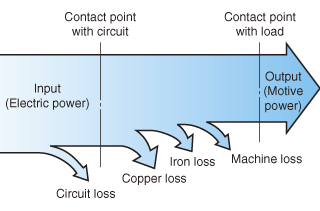1-1. What Is a Motor?
The word "motor" refers to any power unit that generates motion, that is a "prime mover", while "electric motor" refers to a "prime mover using electricity."

An electric motor is a device used to convert electrical energy into mechanical energy.
Scientifically speaking, the electric motor is a unit used to convert electric power into motive energy or electrical energy into mechanical energy. Fig. 1.1 is a flow diagram of energy. The left end of the arrow represents the electrical input and the right end the mechanical output respectively. Electrical input may be simply shortened to read input, and mechanical output (motive energy) can be simply shortened to output.
During the energy conversion process, some input becomes heat instead of motive energy.
This is called loss. In Japan, over 60% of total power generated is used with the motors.
In terms of conserving the environment, design and use of motors with less loss is an important challenge.
The following relationship exists among the above-mentioned input power, output (also called motive energy) and loss:
Input power = mechanical output + loss
Unit for those amounts is Watt [W].
Input power and mechanical output are defined by the following equations:
Input power [W] = Voltage [V] x Current [A]
Mechanical output [W] = Rotating speed [rad/s] x Rotative force [Nm]
(rad is called radian and Nm Newton meter)
Motor efficiency refers to the fraction of mechanical output to input power as a percentage (%).
Loss includes (for example) loss caused by mechanical phenomenon such as friction, but it typically consists of loss in the copper wire and the core. The former is called copper loss and the latter iron loss (see Fig. 1.1 above).

